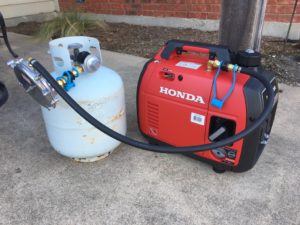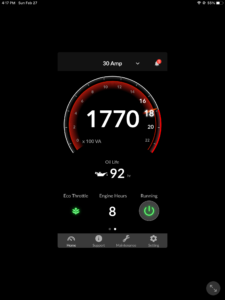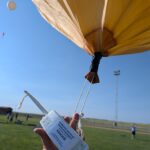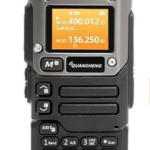By Rob Forson K5WFR
My family and I suffered through several days with no power during the winter storm of February 2021. Long before the inside temperature dropped into the lower 40’s, I swore that we would not be left in that situation again. As soon as the lights came back on, I started investigating different options for generators that could power necessary household equipment during an extended electrical outage.
After considerable research, my preferences were narrowed to:
Portability. I liked the idea of having a portable generator, and I did not feel that the expense of a permanently installed whole home generator would add enough value to a home sale to recoup the investment. And it appears that downsizing is the trendy thing to do when your kid leaves for college.
Inverter. With the electronics used these days and the desire to maintain internet access, I wanted something more than a conventional generator. Both use an alternator, but an inverter generator converts alternating current [AC] power to direct current [DC] power, then back to AC which results in “cleaner” power. Inverters are generally quieter and more fuel efficient, as they automatically throttle up and down depending on the load.
Output. I felt that to remain comfortable during an extended power outage in winter, the necessities would be: keeping the heat running [1100 watts], powering the refrigerator [800 watts], the microwave [1450 watts], lights in one or two rooms [200 watts], the internet router [150 watts] and a few lower powered conveniences, such as a television [120 watts] and phone chargers. In my situation, as we have natural gas heating, I figured that 4 kilowatts should be sufficient for our needs. Due to the initial power draw of a central air conditioning compressor and the need for 240 volts, I did not even try to include that in my consideration.
Alternative fuels. I read multiple times not to store gasoline for more that six months and that fuel stabilizer is a must with a generator as it could be idle for extended periods. The ethanol in today’s blends attracts water and can lead to a gummed carburetor, which could then require a rebuild or replacement. The nearest ethanol free I could find is at Buc-ee’s in Melissa. I do not have a good place to store more than a few gallons of gasoline other than the garage or outdoors, neither of which I wanted to consider. I also did not like the idea of sloshing gasoline in the middle of the night in the dark. I discovered that there are dual fuel [gasoline / propane] generators available. As propane can be stored indefinitely, has lower emissions than gasoline and can be kept in 20, 30, 40 and even 100 lbs or larger tanks, this sounded like the way to go. Especially when the tanks can be refilled locally, or that the smaller tanks can be exchanged at big box stores, gas stations – even pharmacies.
Noise level. I preferred to have a quieter generator, mainly for my sanity. As they frequently annoy me, I wasn’t too worried about annoying the neighbors.
What Did I Choose?
With those in mind, I kept coming back to the Honda inverter generators. Quiet, relatively lightweight, extremely dependable. Unfortunately, they do not come with a fuel option other than gasoline. I then found that kits are available to convert a number of generators, including Honda and other brands, to allow the use of propane. Further investigation led to propane conversion kits that also allow the use of natural gas. This really piqued my interest as I have a natural gas connection in the back yard that had been used for grilling by the previous owner. [Natural gas supply is typically uninterrupted during power outages as the compressors that move the gas are almost always fueled by the gas itself.]

I ultimately decided that I wanted two Honda EU2200i generators [120 volts / 2200 watts each] and to convert both with kits from Hutch Mountain, a Utah based company. The EU2200i weighs 47 pounds, has a carbon monoxide monitor, a runtime of up to 8 hours on a gallon of gasoline and even Bluetooth. The EU2200i is available in two configurations – one with two 15 amp outlets and one with a 15 amp and a 30 amp outlet. Two of either configuration can be connected with a “parallel kit”, which simply consists of three wires, to allow combined power output. Two in combination would give nearly 50% more power than their next larger inverter [3000 watts] for roughly the same price, and still allow the use of just one generator if desired, which is 1/3 the weight of the larger. The Honda app allows you to connect to your generator[s] and monitor output and scheduled maintenance – from indoors!
Conversion to Propane/LPG
The Hutch Mountain kits permit the use of either gasoline or propane and also have a natural gas option. Both the generators and the conversion kits have great reviews. Note: due to the reduced density compared to gasoline, the use of propane derates the output of a generator and natural gas even more so – I saw indications of up to 15%. Even with the derating, I felt I would still have sufficient power for our needs.
Installation of the Hutch Mountain conversion kits can be done in as little as 20 minutes, and only takes a screwdriver, a drill with a pilot bit and a step bit, a couple of adjustable wrenches, an open end wrench and an 8mm socket and ratchet. To change from propane to natural gas, a hose is disconnected from the carburetor plate, the LPG jet unscrewed, the natural gas jet screwed in and the hose reconnected. There are several videos online that demonstrate the installation of the kit – one good one is by “Fate Unbound.” (see below)

Warning: Honda states that their warranties are void if any modifications are done to their equipment. After reading the reviews about their dependability, the number of installs and that Hutch Mountain claims they support the original warranty, I decided to take the chance the Honda warranty wouldn’t be needed.
How Do You Hook It Up?
To connect the generator to the home breaker box and avoid having extension cords running in a window, I found two options: a transfer switch and an interlock kit. Both options allow a generator to be connected to the breaker box via a dedicated outlet and allow power to be supplied by either the grid or the generator at any one time, but not both. A transfer switch is connected to select circuits during installation; an interlock kit energizes the entire breaker box and allows any circuit to be switched on or off – the only limit is the maximum generator output. Be advised – I am not an electrician or an electrical engineer. And I must add that I read over and over – NEVER back feed a breaker box. It is dangerous and illegal.
Side note: As I was fine tuning my plan, I described it to Uncle Bubba, a family member who laughed at the idea. A couple of months later, I received a video of his two brand new Hondas running on natural gas.
An article in the January 16, 2022 Dallas Morning News stated that Texas currently has 130 gigawatts of installed baseload power. ERCOT believes we will need an additional 100 gigawatts of baseload power in 15 years. Anyone know how long it takes to build a power plant?
There are many options regarding ways to provide emergency power – I mainly intended to pass along what I learned during my research. Questions or comments are welcome.
A few tips: To save some money, buy generators, etc. on Emergency Preparedness Supplies Sales Tax Holiday Weekend in April. Devise a way that any portable generator does not walk off during unattended use. To limit power use while running on generator power, switch off or unplug higher amperage appliances such as the refrigerator while using something like the microwave. For reference, at 60 degrees Fahrenheit, 1 pound of propane is 0.24 gallons; inversely, 1 gallon of propane is 4.24 pounds.
Full disclosure: I do not have any ties to either Honda or Hutch Mountain, if you don’t count the 18 year old Honda lawn mower sitting in my garage. My company, however, does have extensive connections to oil and gas exploration and production, from which gasoline, propane and natural gas are all derived. This did not influence any of my decisions – however, I am a big fan of their use!





